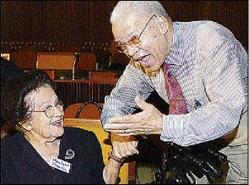
Sybil Francis (left), former director of the Social Welfare Training Centre and chairman of the National Council for Senior Citizens, shares a light moment with Clinton Davis, president of the Jamaica Government Pensioners' Association at the National Consultation on Survey Results of Older Persons in Selected Communities held at the Jamaica Conference Centre in Kingston, on Wednesday.
- Rudolph Brown/Chief Photographer
With a significant number of Jamaica's senior citizens living below the poverty line, Andrew Gallimore, state minister in the Ministry of Labour and Social Security, has called on all working Jamaicans, both in the formal and informal sector, to start making plans for retirement.
Gallimore, who has portfolio responsibility for senior citizens, said too many Jamaicans failed to prepare for the future and so face serious difficulties in finding basic necessities when they are no longer earning an income.
Failed to plan
"In my estimation, what we have failed to do as a people and as a country is to plan for retirement and old age," he said. "We have not been seizing the opportunities that exist."
Gallimore was speaking Wednesday, during the launch of the National Consultation on Survey Results of Older Persons in Selected Communities, held at the Jamaica Conference Centre, downtown Kingston.
The survey found that a large number of Jamaican senior citizens were living in significant poverty, barely able to finance their daily existence.
The study, which was organised by HelpAge International and conducted throughout some eight St Catherine, Kingston and St Andrew communities, also reported that many senior citizens were living in deplorable housing conditions with little or no money for health services.
Gallimore said that, while it was the responsibility of the Government to ensure that its older citizens are being taken care of, he said it was also crucial for individuals to take the task of preparing for old age very seriously.
According to Gallimore, less than 30 per cent of people 60 years old and over were benefiting from the National Insurance Scheme (NIS). He said this meant that almost 70 per cent of Jamaicans made no plans for retirement.
"I urge every person who is not of retirement age to get involved, to make contributions to the NIS," he said. "If you have the ability to make contributions to a private scheme in addition to the NIS, do it now, while you are young," said Gallimore.
Gallimore said an International Development Bank study showed that 57 per cent of Jamaicans in the informal sector make no contribution to the NIS, despite provisions being made as far back as 1966 for individuals who were not employed to a structured company to make payments to the scheme.
"The NIS pension is meant to be a minimum guaranteed replacement income for retirement," he said. "It too is not a lot of money, but it is better than no money."
The following represents the major findings of the survey:
A total of 1,075 senior citizens from eight communities were interviewed.
55 per cent of the respondents were female and 45 per cent male.
Key Challenges
Not having enough money to meet expenses was the main challenge identified by the respondents. In this regard, the deplorable condition of houses and the inability to undertake necessary repairs due to little or no income; inability to pay utility bills, and high transportation cost were all significant concerns.
Income and Employment
15 per cent of respondents were employed.
the main source of income for respondents came from family members in general (62 per cent). Of this figure, the main support was provided by children, who accounted for 40 per cent, grandchildren 12 per cent and other family members 10 per cent.
Females relied more on family as their main source of income while more males relied on self employment and friends.
Access to Health Care
81 per cent of respondents suffered from one health condition or another.
Those suffering from a health condition comprised 89 per cent females compared to 73 per cent males.
Most respondents went for medical treatment on a quarterly basis (41 per cent).
The cost of accessing health care in rural communities was almost twice that of urban areas.
Access to Social Assistance Programmes
87 per cent of respondents suffered from one or more illness covered under the NHF/JADEP programme.
50 per cent of the respondents were aware of the social assistance programme, but only 25 per cent were accessing these programmes. This indicated to 50 per cent awareness gap and a 75 per cent beneficiary gap.

